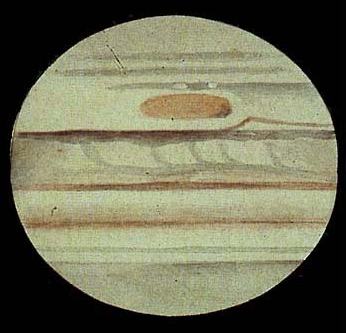Jupiter’s Great Red Spot – a storm larger than our whole planet – is one of the most visible features of the Solar System, thought to date to not long after the invention of the telescope, if not much earlier. However, new evidence suggests it instead originated in 1831 and has been mistaken for being a continuation of a previous spot from a century before, making it much, much younger than thought.
Galileo’s adaptation of the telescope for astronomical purposes famously revealed features like the moons of Jupiter and sunspots for the first time. As instruments improved, astronomers noticed that Jupiter had dark and light bands parallel to its equator, with dark spots sometimes appearing in the normally white latitudes.
In 1665, Giovanni Cassini, immortalized for discovering the largest gap in Saturn’s rings, was probably the first to report a dark oval subsequently known as the “Permanent Spot”. However, a report from 1832 might have been of the same thing. Since the spot rotated with Jupiter, it could only be seen for about five hours at a time, before disappearing onto the far side, but provided the viewer was patient, it would always return, while other spots came and went. That is until 1713, when it faded to invisibility and disappeared for 100 years.
In 1831 the spot was back, and attracted the name the Great Red Spot, or so the conventional story goes. Books on the wonders of the Solar System generally state that the storm shrank to be too small for the modest telescopes of the 18th century to pick up, before rebounding. Given that the Great Red Spot has changed in size many times over almost two centuries – currently frustrating amateur astronomers by shrinking to about the size of Earth – this tale appears highly plausible.
However, according to new research, it’s also wrong. Instead, a team led by Professor Agustín Sánchez-Lavega of Universidad del País Vasco claims, that the Permanent Spot and the Great Red Spot are probably unrelated, making the current Spot just 193 years old.

Jupiter painted in 1881, showing the enormous size of the Spot at the time. Jupiter is upside down as a result of the telescope used.
Image Credit: Thomas Gwyn Elgar Public Domain
The Permanent Spot and the Great Red Spot are both in Jupiter’s low-to-mid southern latitudes, leading astronomers to conflate the two. However, the Great Red Spot is, well, red, even though we still don’t know why (it has a blue spot too, though it’s not really blue). We have records of astronomers reporting seeing the Permanent Spot many times over the years; the authors of the new study note that none refer to a color, although a painting made in 1711 does show a red tint.
Telescopes improved only slowly during the 118 years when Jupiter was relatively spotless, but giants of astronomy such as Charles Messier and William Herschel described the planet using telescopes better than their predecessors, without reporting anything at that latitude.
The researchers also argue the Spot we currently see is probably the result of a disturbance in the flow of zonal jets to the north and south of it. This contrasts with the more common explanations: the merging of multiple smaller vortices or a super-storm. The team modeled the formation of an anticyclonic superstorm on Jupiter based on Saturn’s giant 100-year storms. Irrespective of their assumptions, however, they always got something smaller than the early descriptions of the Great Red Spot. Anti-cyclonic vortices merge on Jupiter, but the authors found that to produce something as large as the Great Red Spot, it would need to rotate far faster than it currently does.
Readjusting the Spot’s age would fundamentally alter how we see Jupiter’s atmosphere. If a spot has been there since at least 1665 then it is likely it was there long before, perhaps for millions of years, with no one having the capacity to observe it. The storm towering 8 kilometers (5 miles) above the rest of Jupiter’s clouds would then be considered a near-permanent part of our Solar System, and its current shrinkage would be anticipated to reverse soon enough.
On the other hand, if this analysis is right, the Great Red Spot might well be on its last legs, struggling to make it to the 200-year mark before vanishing in a puff of ammonia-enriched hydrogen.
The modern Spot is sometimes compared to a giant rolling eye, but it seems that if Jupiter is keeping track of the smaller planets, that comes with long blinks.
An awful lot happened between 1665 and 1831, so if the Great Red Spot really was formed around the time reports restarted then it would be younger than intercity railways (1830) and computers (1822). It is, however, slightly older than Jonathan, the world’s oldest living tortoise.
The study is open access in Geophysical Research Letters.
Source Link: Jupiter’s Great Red Spot May Be Younger Than The United States